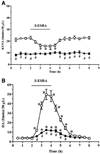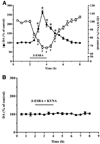Specific inhibition of kynurenate synthesis enhances extracellular dopamine levels in the rodent striatum
- PMID: 19138730
- PMCID: PMC3073137
- DOI: 10.1016/j.neuroscience.2008.11.055
Specific inhibition of kynurenate synthesis enhances extracellular dopamine levels in the rodent striatum
Abstract
Fluctuations in the endogenous levels of kynurenic acid (KYNA), a potent alpha7 nicotinic and NMDA receptor antagonist, affect extracellular dopamine (DA) concentrations in the rat brain. Moreover, reductions in KYNA levels increase the vulnerability of striatal neurons to NMDA receptor-mediated excitotoxic insults. We now assessed the role of a key KYNA-synthesizing enzyme, kynurenine aminotransferase II (KAT II), in these processes in the rodent striatum, using KAT II KO mice-which have reduced KYNA levels-and the selective KAT II inhibitor (S)-4-(ethylsulfonyl)benzoylalanine (S-ESBA) as tools. S-ESBA (applied by reverse dialysis) raised extracellular DA levels in the striatum of KYNA-deficient mice threefold and caused a much larger, 15-fold increase in wild-type mice. In the rat striatum, S-ESBA produced a 35% reduction in extracellular KYNA, which was accompanied by a 270% increase in extracellular DA. The latter effect was abolished by co-infusion of 100 nM KYNA. Intrastriatal S-ESBA pre-treatment augmented the size of a striatal quinolinate lesion by 370%, and this potentiation was prevented by co-infusion of KYNA. In separate animals, acute inhibition of KAT II reduced the de novo synthesis of KYNA during an early excitotoxic insult without enhancing the formation of the related neurotoxic metabolites 3-hydroxykynurenine and quinolinate. Taken together, these results provide further support for the concept that KAT II is a critical determinant of functionally relevant KYNA fluctuations in the rodent striatum.
Figures




References
-
- Agnati LF, Fuxe K. Volume transmission as a key feature of information handling in the central nervous system possible new interpretative value of the Turing's B-type machine. Prog Brain Res. 2000;125:3–19. - PubMed
-
- Alkondon M, Pereira EF, Yu P, Arruda EZ, Almeida LE, Guidetti P, Fawcett WP, Sapko MT, Randall WR, Schwarcz R, Tagle DA, Albuquerque EX. Targeted deletion of the kynurenine aminotransferase II gene reveals a critical role of endogenous kynurenic acid in the regulation of synaptic transmission via alpha7 nicotinic receptors in the hippocampus. J Neurosci. 2004;24:4635–4648. - PMC - PubMed
-
- Barik J, Wonnacott S. Indirect modulation by alpha7 nicotinic acetylcholine receptors of noradrenaline release in rat hippocampal slices: interaction with glutamate and GABA systems and effect of nicotine withdrawal. Mol Pharmacol. 2006;69:618–628. - PubMed
-
- Calabresi P, Pisani A, Mercuri NB, Bernardi G. The corticostriatal projection: from synaptic plasticity to dysfunctions of the basal ganglia. Trends Neurosci. 1996;19:19–24. - PubMed
Publication types
MeSH terms
Substances
Grants and funding
LinkOut - more resources
Full Text Sources
Molecular Biology Databases
Research Materials

